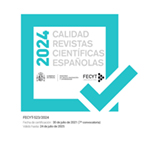Conceptual tropes in the divinatory codices of Central Mexico
Abstract
Conceptual tropes are figures of classical rhetoric considered to be mechanisms of the mind, which are therefore susceptible to expression in language, as well as in graphics, artefacts and gestures. They formed the means of communication between the two worlds, the visible and the invisible, in which the inhabitants of central Mexico believed before the conquest. In order to help decipher the divinatory codices, the article defines the three main tropes - synecdoche, metonymy and metaphor - as well as metalepsis and silepsis and shows how they were combined with "definition by extension" which produces a series of signs. It concludes by proving the validity of this method of analysis on glyphs related to war and sacrifice and bringing to light various nuances of their meaning.
Downloads
Article download
License
In order to support the global exchange of knowledge, the journal Revista Española de Antropología Americana is allowing unrestricted access to its content as from its publication in this electronic edition, and as such it is an open-access journal. The originals published in this journal are the property of the Complutense University of Madrid and any reproduction thereof in full or in part must cite the source. All content is distributed under a Creative Commons Attribution 4.0 use and distribution licence (CC BY 4.0). This circumstance must be expressly stated in these terms where necessary. You can view the summary and the complete legal text of the licence.









